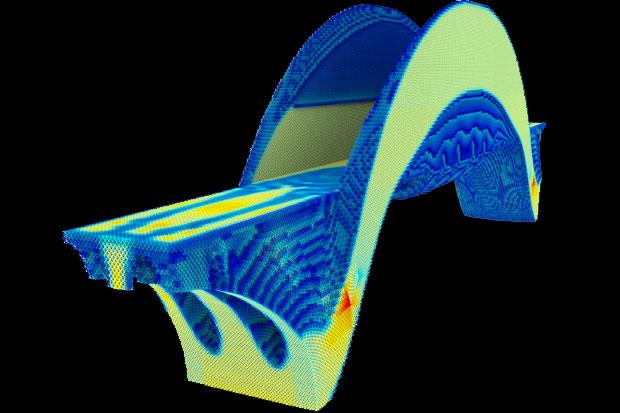The Livermore Design Optimization (LiDO) code is used by designers and analysts to optimize designs. A classic example is to design the lightest structure that can withstand its loading environment. To do this, LiDO combines simulation, solver and optimization LLNL software libraries. In this way, it can solve design problems much larger than current commercially available software. Moreover, since LiDO is built on existing LLNL simulation codes, it can be readily extended to accommodate additional physics, nonlinear and transient effects and multiple length scales. The shortcoming of LiDO is its lack of a user interface. LLNL would like to partner with a CAD company via an API to enable a software capability that allows designers to input a design via the CAD software, optimize its geometry via LiDO and then send it to a shop floor for fabrication via the CAD software.
The LiDO code combines finite element analysis, design sensitivity analysis and nonlinear programming in a High-Performance Computing (HPC) environment that enables the solution of large-scale structural optimization problems in a computationally efficient manner. Currently, the code uses topology optimization strategies in which a given material is optimally distributed throughout the domain. Originally the code parameterized the material's characteristic function field as piece-wise uniform over the finite elements, however this proved problematic when implementing LiDO's Adaptive Mesh Refinement (AMR) strategies. LiDO has since implemented higher-level parameterizations for the material's characteristic function field. One such parameterization uses the level-set function of an implicit geometry description of the structural component. Preliminary results using this approach are promising. To fully realize this approach's potential, LiDO must link to a computer-aided engineering (CAE) software that can provide the ability to model complex engineering relevant design geometries. This link will be in the form of an API. In this way, engineers can specify an initial design in the CAE software, have LiDO optimize the design and finally use the CAE software to send the design to the manufacturing floor for production.
The key aspects of LiDO are its abilities to
- Solve large-scale design problems via its HPC implementation
- Use of AMR to ensure accurate simulations in a computational tractable manner
- Its modular design which enables the easy implantation of, e.g. multiphysics, transients, nonlinearities etc.
The key aspects of CAD are its abilities to
- Model complex geometric components
- Visualize these models
- Interface with manufacturing machines, e.g. 3D printers
This API project will develop a software environment that leverages the strengths of the LiDO and CAD softwares.
There are several structural optimization programs that are currently available, but only the combined LiDO and CAD software environment will be able to
- Solve large-scale design optimization problems
- Utilize AMR capabilities
- Have user friendly interfaces to define initial designs
- Have user amenable interfaces with manufacturing process machines
The LiDO code is still under development; however, it has been used to:
- Solve design optimization problems in excess of 1 billion design parameters
- Demonstrate the use of AMR
- Incorporate complex constraints, such as on the maximum stress.
- Use level-set type parameterizations, cf. Daniel White, Mark Stowell, Daniel Tortorelli, "Topological optimization of structures using Fourier representations", Structural and Multidisciplinary Optimization, 58, pp. 1205-1220, 2018
LLNL is seeking industry partners with a demonstrated ability to bring such inventions to the market. Moving critical technology beyond the Laboratory to the commercial world helps our licensees gain a competitive edge in the marketplace. All licensing activities are conducted under policies relating to the strict nondisclosure of company proprietary information.


